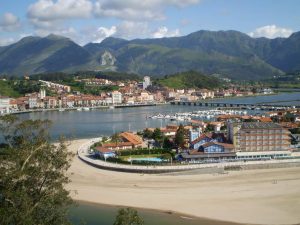
Barcelos is a city steeped in rich history, known not only for its connection to the Camino de Santiago but also as the birthplace of the iconic Portuguese symbol, the Galo de Barcelos. This legendary figure symbolizes the tale of a pilgrim wrongly accused who found salvation, adding a special aura to the city.
This place is situated in the fertile Minho region, in northern Portugal. Barcelos is strategically located on the Portuguese Way. Its location makes the city a historical haven for pilgrims seeking adventure, spirituality, and a warm welcome while traversing this ancient path.
Índice de contenidos
History of Barcelos

To begin with, as a company specializing in Caminos de Santiago de Compostela tours, we will discuss its history.
Barcelos has its roots in the Middle Ages, a period during which the city developed significantly due to its strategic location. The proximity of this city to this pilgrimage route influenced its flourishing as a commercial and cultural centre, attracting travellers, merchants, and pilgrims who enriched the city’s life with their exchanges and traditions.
Christianity has played a central role in shaping the identity of this place. The city’s history is deeply intertwined with the Christian faith, particularly through the myth of the Galo de Barcelos.
According to the legend, a pilgrim on his way to Santiago was miraculously saved from hanging thanks to a miracle involving a cooked rooster that crowed to prove his innocence.
This story not only strengthened local faith but also attracted more pilgrims interested in the Camino de Santiago, eager to explore this mystical city and its emblematic symbol of miracle and redemption. Even those undertaking the Sarria to Santiago de Compostela organised tour are curious about Barcelos and its myth.
Religious Heritage and the Camino de Santiago
Barcelos is a crucial link on the Portuguese Way to Santiago de Compostela. The city is renowned for its rich history and culture, as well as its significant religious heritage that offers spiritual support and refuge to pilgrims on their journey.
Next, we explore some of the most significant religious monuments in this place, which serve as beacons of light and devotion on this ancient path of faith. Similar to the various stages of the French Way or the Northern Way, you will find several points of interest.
Church of Santa Maria

A majestic example of Gothic architecture that stands as a central monument in the spiritual life of Barcelos.
Built in the 14th century, this church is a testament to the influence of the Portuguese Way in the region, and its impressive stone structure reveals centuries of religious devotion. Pilgrims find here a place of peace and prayer before continuing on their way.
Chapel of the Lord of the Cross
This chapel is an important stop for pilgrims travelling to Santiago, as it houses a miraculous cross. According to local tradition, the cross was discovered by a farmer and quickly became a symbol of faith and hope for travellers. Pilgrims often stop here, seeking comfort and blessings before resuming their journey.
Convent of San Francisco
With impressive sacred art that combines Gothic and Baroque elements, the Convent of San Francisco has been a refuge for pilgrims for centuries. Its ornate interior decoration and tranquil atmosphere make it a perfect place for meditation and reflection on the Portuguese Way.
Historical and Cultural Monuments
With its charming medieval atmosphere, this city is not only an important milestone even for those doing the Portuguese Way from Tui in 5 stages (Barcelos is the starting point of the previous stage). It also hosts a variety of historical and cultural monuments.
These sites reflect the city’s rich heritage, where past and present intertwine to offer pilgrims and visitors a unique cultural immersion experience.
- Barcelos Tower: this tower, a vestige of a medieval fortress, was a key defensive bastion that protected the city for centuries. Built in the 15th century, it offers insight into the military importance of the region in ancient times. Today, the tower stands as a symbol of Barcelos’ strategic past.
- Archaeological Museum: this open-air museum is located in the ruins of the Palace of the Counts of Barcelos. Its exhibits comprise an impressive collection of artefacts that tell the religious and cultural history of the city, providing visitors with a window into life in past times.
Traditions and Festivities
Religious fervour and popular creativity converge in its festivals and artisanal expressions, reflecting the identity and history of the people. These celebrations and local products offer visitors a vibrant experience, as well as strengthen the sense of community among inhabitants. Here are two highlights that reveal Barcelos’ rich culture:
- Festival of the Crosses: celebrated in May, this festival has profound religious and cultural significance for the city’s inhabitants. It honours the miraculous cross and attracts numerous pilgrims and visitors seeking blessings and participating in processions, fairs, and religious activities, highlighting the city’s devotion.
- Local Crafts: as you might expect, one of the city’s most distinctive emblems is the Galo de Barcelos, a colourful ceramic figure that represents the famous local legend of the rooster that crowed to save a pilgrim’s life.
- Weekly Market: the bustling weekly market is a vibrant tradition of this place. Every Thursday, both pilgrims and locals gather to buy and sell fresh produce, crafts, and other items. The market becomes a colourful cultural mosaic that gives travellers an opportunity to immerse themselves in the essence of the city.
Barcelos is a historical and cultural gem that captivates with its religious heritage, colourful traditions, and warm hospitality. We invite you to stroll through its streets, explore its history, and experience its culture, allowing this city to surprise you with every corner and every shared story.









